[Webinar] Kafka + Disaster Recovery: Are You Ready? | Register Now
Stream Processing, CEP, Event Sourcing, and Data Streaming Explained
Some people call it stream processing. Others call it event streaming, complex event processing (CEP), or CQRS event sourcing. Sometimes, such buzzwords are just smoke and mirrors, invented by companies who want to sell you stuff. But sometimes, they contain a kernel of wisdom, leading to better technologies that help us design better systems.
In this talk, we’ll delve into what event stream processing is, and how they differ from event sourcing or complex event processing. Founded in the experience of building large-scale data systems at LinkedIn, and implemented in open-source stream processing systems like Apache Kafka and Apache Samza, event streaming is finally coming of age.
Finally, we’ll also discuss the fundamentals of each, how they work, and how real-time data streams can help make your application more scalable, more reliable, and more maintainable.
This is an edited transcript of a talk I gave at /dev/winter 2015.
In this presentation, I’m going to discuss some of the ideas that people have about event stream processing. The idea of structuring data as a stream of events is nothing new, but I’ve recently noticed this idea reappearing in many different places, often with different terminology and different use cases, but with the same underlying principles.
The problem when a technique becomes fashionable is that people start generating a lot of hype and buzzwords around it, often reinventing ideas that are already commonplace in a different field, but using different words to describe the same thing. In this talk I’m going to try to cut through some of the hype and jargon in the general area of stream processing, and try to break it down by fundamental ideas.
Although the jargon can be off-putting when you first encounter it, there’s no need to be scared. A lot of the ideas are quite simple when you get down to the core. Also, there are a lot of good ideas which are worth learning about, because they can help us build applications better.

The notion of event processing appears in many different areas, which is really confusing at first. People in different fields use different vocabulary to refer to the same thing. I think this is mainly because the techniques originated in different communities of people, and people seem to often stick within their own community and not look at what their neighbours are doing.
The current tools for distributed stream processing have come out of internet companies like LinkedIn, with philosophical roots in database research of the early 2000s. On the other hand, complex event processing (CEP) originated in event simulation research in the 1990s and is now used for operational purposes in enterprises. Event sourcing has its roots in the domain-driven design community, which deals with enterprise software development — people who have to work with very complex data models, but often smaller datasets than the internet companies.
My background is in internet companies, but I’m doing my best to understand the jargon of the other communities, and figure out the commonalities and differences. If I’ve misunderstood something, please correct me.

To make this concrete, I’m going to start by giving an example from the field of stream processing, specifically real-time analytics. I’ll then draw parallels with other areas.

To start with, take something like Google Analytics. As you probably know, Google Analytics is a bit of Javascript that you can put on your website, and that keeps track of which pages have been viewed by which visitors. An administrator can then explore this data, breaking it down by time period, or by URL, and so on.
How would you implement something like Google Analytics?
First take the input to the system. Every time a user views a page, we need to log an event to record that fact. A page view event may look something like this (using a kind of pseudo-JSON):
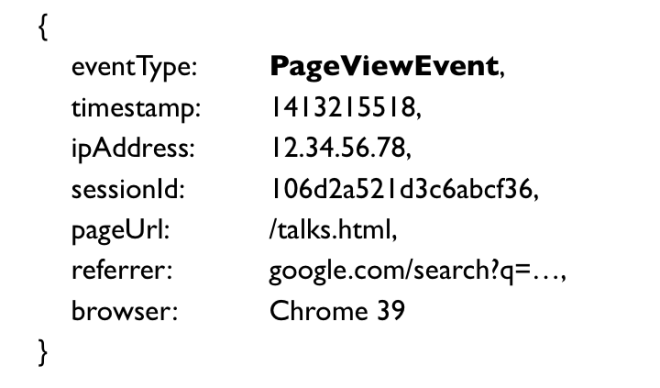
A page view has an event type (PageViewEvent), a Unix timestamp that indicates when the event happened, the IP address of the client, the session ID (this may be a unique identifier from a cookie, which allows you to figure out what series of page views is from the same person), the URL of the page that was viewed, how the user got to that page (for example, from a search engine, or clicking a link from another site), the user’s browser and language settings, and so on.
Note that each page view event is a simple, immutable fact. It simply records that something happened.
Now, how do you go from these page view events to the nice graphical dashboard on which you can explore how people are using your website?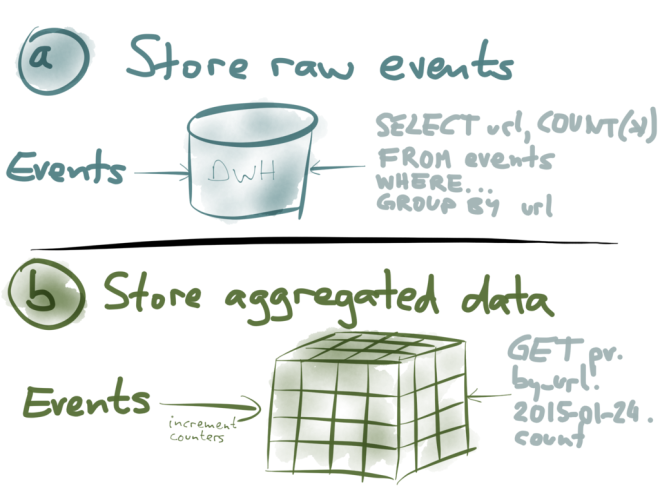
Broadly speaking, you have two options.
Option (a): you can simply store every single event as it comes in, dump them all in a big database, a data warehouse or a Hadoop cluster. Now, whenever you want to analyze this data in some way, you run a big SELECT query against this dataset. For example, you might group by URL and by time period, you might filter by some condition, and then COUNT(*) to get the number of page views for each URL over time. This will scan over essentially all the events, or at least some large subset, and do the aggregation on the fly.
Option (b): if storing every single event is too much for you, you can instead store an aggregated summary of the events. For example, if you’re counting things, you increment a few counters every time an event comes in, and then you throw away the actual event. You might keep several counters in something that’s called an OLAP cube: imagine a multi-dimensional cube, where one dimension is the URL, another dimension is the time of the event, another dimension is the browser, and so on. For each event, you just need to increment the counters for that particular URL, that particular time, etc.
With an OLAP cube, when you want to find the number of page views for a particular URL on a particular day, you just need to read the counter for that combination of URL and date. You don’t have to scan over a long list of events; it’s just a matter of reading a single value.
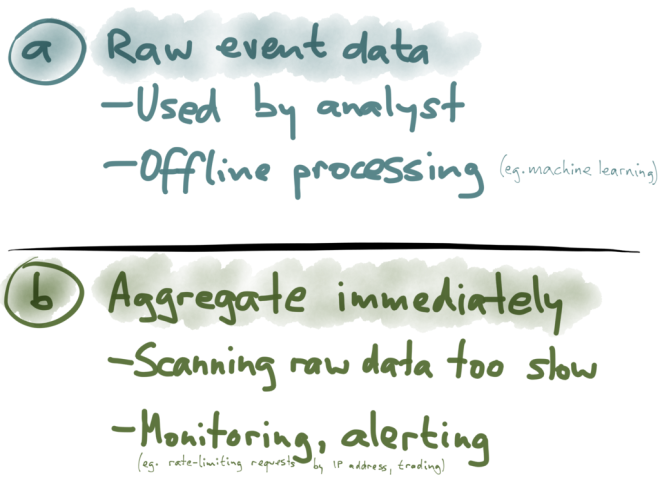
Now option (a) may sound a bit crazy, but it actually works surprisingly well. I believe Google Analytics actually does store the raw events, or at least a large sample of events, and performs a big scan over those events when you look at the data. Modern analytic databases have become really good at scanning quickly over large amounts of data.
The big advantage of storing raw event data is that you have maximum flexibility for analysis. For example, you can trace the sequence of pages that one person visited over the course of their session. You can’t do that if you’ve squashed all the events into counters. That sort of analysis is really important for some offline processing tasks, such as training a recommender system (“people who bought X also bought Y”, that sort of thing). For such use cases, it’s best to simply keep all the raw events, so that you can later feed them all into your shiny new machine learning system.
However, option (b) also has its uses, especially when you need to make decisions or react to things in real time. For example, if you want to prevent people from scraping your website, you can introduce a rate limit, so that you only allow 100 requests per hour from any particular IP address; if a client goes over the limit, you block it. Implementing that with raw event storage would be incredibly inefficient, because you’d be continually re-scanning your history of events to determine whether someone has gone over the limit. It’s much more efficient to just keep a counter of number of page views per IP address per time window, and then you can check on every request whether that number has crossed your threshold.
Similarly, for alerting purposes, you need to respond quickly to what the events are telling you. For stock market trading, you also need to be quick.
The bottom line here is that raw event storage and aggregated summaries of events are both very useful. They just have different use cases.
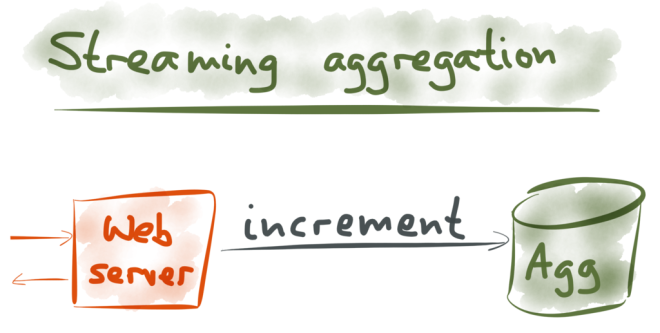
Let’s focus on those aggregated summaries for now. How do you implement those?
Well, in the simplest case, you simply have the web server update the aggregates directly. Say you want to count page views per IP address per hour, for rate limiting purposes. You can keep those counters in something like memcached or Redis, which have an atomic increment operation. Every time a web server processes a request, it directly sends an increment command to the store, with a key that is constructed from the client IP address and the current time (truncated to the nearest hour).
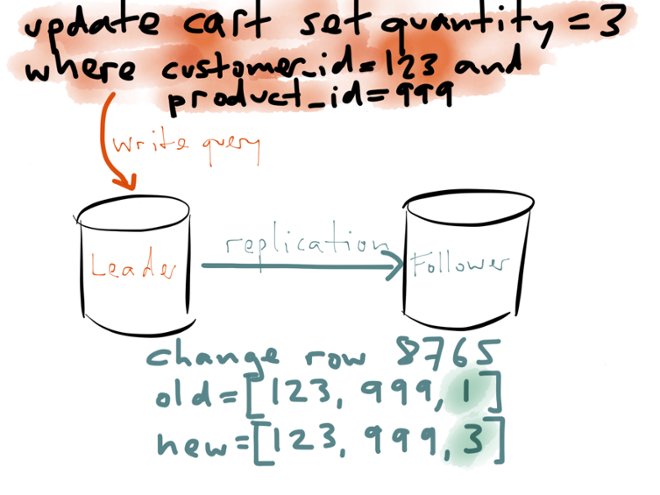 If you want to get a bit more sophisticated, you can introduce an event stream, or a message queue, or an event log, or whatever you want to call it. The messages on that stream are the PageViewEvent records that we saw earlier: one message contains the properties of one particular page view.
If you want to get a bit more sophisticated, you can introduce an event stream, or a message queue, or an event log, or whatever you want to call it. The messages on that stream are the PageViewEvent records that we saw earlier: one message contains the properties of one particular page view.
The nice thing about this architecture is that you can now have multiple consumers for the same event data. You can have one consumer which simply archives the raw events to some big storage; even if you don’t yet have the capability to process the raw events, you might as well store them, since storage is cheap and you can use them in future. Then you can have another consumer which does some aggregation (for example, incrementing counters), and another consumer which does something else. Those can all feed off the same event stream.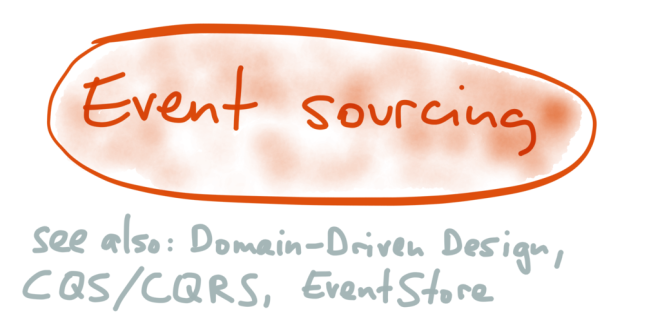
Let’s now change topic for a moment, and look at similar ideas from a different field. Event sourcing is an idea that has come out of the domain-driven design community — it seems to be fairly well known amongst enterprise software developers, but it’s totally unknown in internet companies. It comes with a large amount of jargon that I find very confusing, but there seem to be some very good ideas in event sourcing.
So I’m going to try to extract those good ideas without going into all the jargon, and we’ll see that there are some surprising parallels with my last example from the field of stream processing analytics.
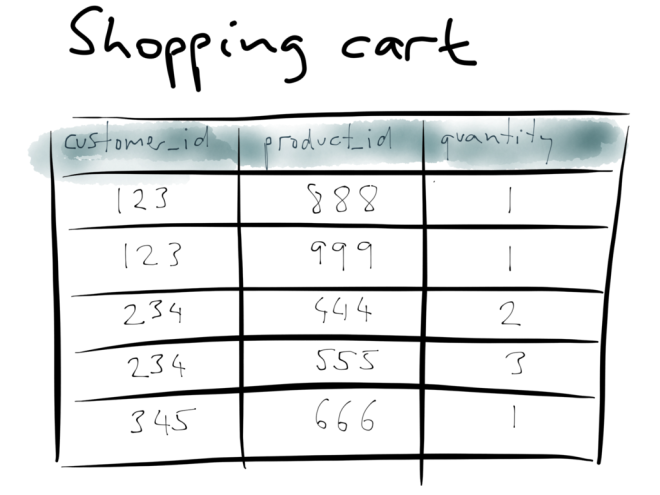
Event sourcing is concerned with how we structure data in databases. As example database I’m going to use a shopping cart from an e-commerce website. Each customer may have some number of different products in their cart at one time, and for each item in the cart there is a quantity. Nothing very complicated here.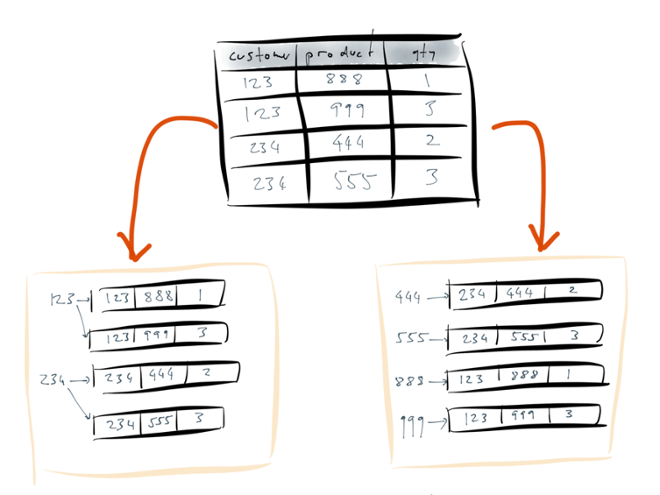
Now say that customer 123 updates their cart: instead of quantity 1 of product 999, they now want quantity 3 of that product. You can imagine this being recorded in the database using an UPDATE query, which matches the row for customer 123 and product 999, and modifies that row, changing the quantity from 1 to 3.
This example uses a relational data model, but that doesn’t really matter. With most non-relational databases you’d do more or less the same thing: overwrite the old value with the new value when it changes.
However, event sourcing says that this isn’t a good way to design databases. Instead, we should individually record every change that happens to the database.
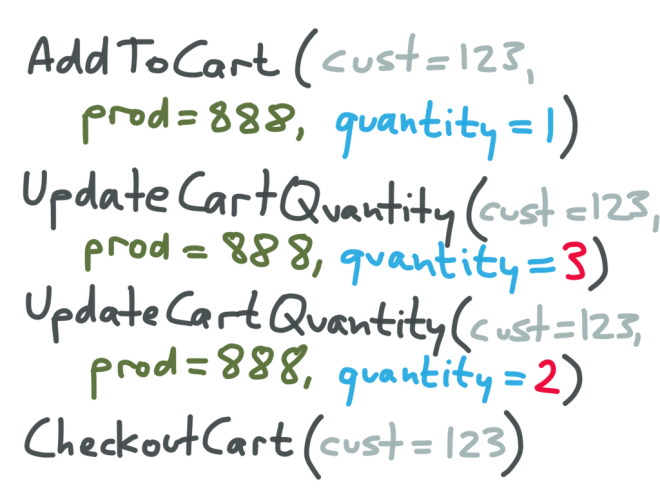
For example, we first record an AddToCart event when customer 123 first adds product 888 to their cart, with quantity 1. We then record a separate UpdateCartQuantity event when they change the quantity to 3. Later, the customer changes their mind again, and reduces the quantity to 2, and finally they go to the checkout. Each of these actions is recorded as a separate event, and appended to the database. You can imagine having a timestamp on every event too.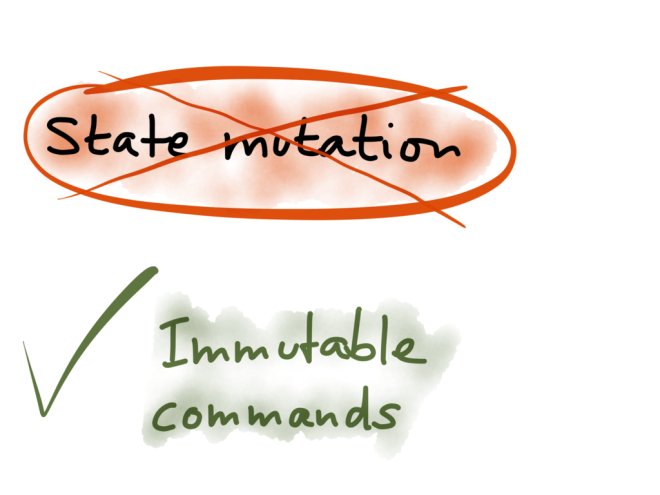 When you structure the data like this, every change to the shopping cart is an immutable event — a fact. Even if the customer did change the quantity to 2, it is still true that at a previous point in time, the selected quantity was 3. If you overwrite data in your database, you lose this historic information. Keeping the list of all changes as a log of immutable events thus gives you strictly richer information than if you overwrite things in the database.
When you structure the data like this, every change to the shopping cart is an immutable event — a fact. Even if the customer did change the quantity to 2, it is still true that at a previous point in time, the selected quantity was 3. If you overwrite data in your database, you lose this historic information. Keeping the list of all changes as a log of immutable events thus gives you strictly richer information than if you overwrite things in the database.
And this is really the essence of event sourcing: rather than performing destructive state mutation on a database when writing to it, we should record every write as a “command”, as an immutable event.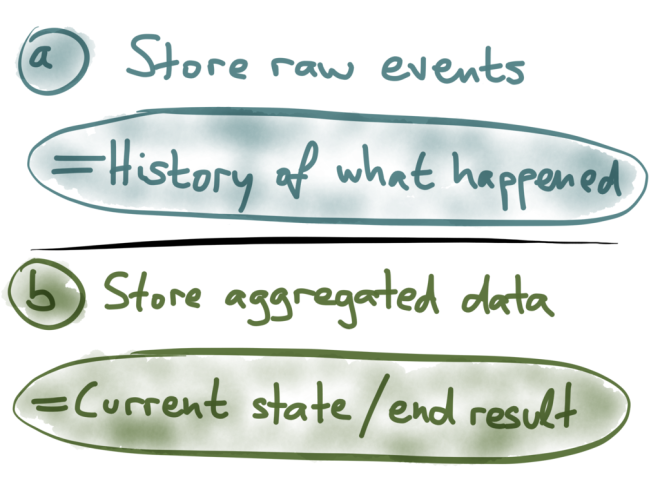 And that brings us back to our stream processing example (Google Analytics). Remember we discussed two options for storing data: (a) raw events, or (b) aggregated summaries.
And that brings us back to our stream processing example (Google Analytics). Remember we discussed two options for storing data: (a) raw events, or (b) aggregated summaries.
What we have here with event sourcing is looking very similar. You can think of those event-sourced commands (AddToCart, UpdateCartQuantity) as raw events: they comprise the history of what happened over time. But when you’re looking at the contents of your shopping cart, you see the its current state — the end result, which is what you get when you have applied the entire history of events and squashed them together into one thing.
So the current state of the cart may say quantity 2. The history of raw events will tell you that at some previous point in time the quantity was 3, but that the customer later changed their mind and updated it to 2. The aggregated end result only tells you that the current quantity is 2.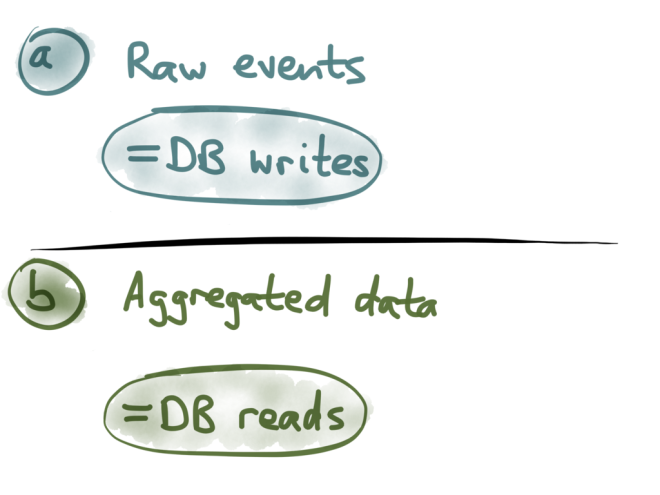 Thinking about it further, you can observe that the raw events are the form in which it’s ideal to write the data: all the information in the database write is contained in a single blob. You don’t need to go and update five different tables if you’re storing raw events — you only need to append the event to the end of a log. That’s the simplest and fastest possible way of writing to a database.
Thinking about it further, you can observe that the raw events are the form in which it’s ideal to write the data: all the information in the database write is contained in a single blob. You don’t need to go and update five different tables if you’re storing raw events — you only need to append the event to the end of a log. That’s the simplest and fastest possible way of writing to a database.
On the other hand, the aggregated data is the form in which it’s ideal to read data from the database. If a customer is looking at the contents of their shopping cart, they are not interested in the entire history of modifications that led to the current state — they only want to know what’s in the cart right now. So when you’re reading, you can get the best performance if the history of changes has already been squashed together into a single object representing the current state.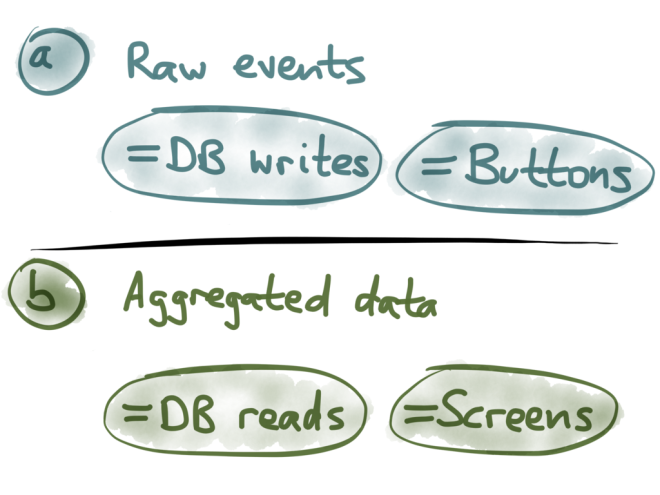 Going even further, think about the user interfaces that lead to database writes and database reads. A database write typically happened because the user clicked some button: for example, they edited some data, and now they click the save button. So, buttons in the user interface correspond to raw events in the event sourcing history.
Going even further, think about the user interfaces that lead to database writes and database reads. A database write typically happened because the user clicked some button: for example, they edited some data, and now they click the save button. So, buttons in the user interface correspond to raw events in the event sourcing history.
On the other hand, a database read typically happens because the user views some screen: they click on some link or open some document, and now they need to read the contents. These reads typically want to know the current state of the database. So screens in the user interface correspond to aggregated state.
This is quite an abstract idea, so let me go through a few examples.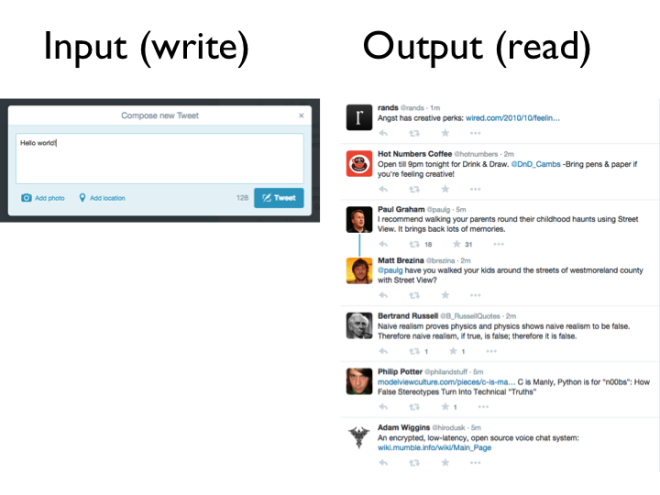
Take Twitter, for example. The most common way of writing to Twitter’s database — i.e. to provide input into the Twitter system — is to tweet something. A tweet is very simple: it consists of some text, a timestamp, and the ID of the user who tweeted. (Perhaps optionally a location, or a photo, or something.) The user then clicks that “Tweet” button, which causes a database write to happen, i.e. an event is generated.
On the output side, the way how you read from Twitter’s database is by viewing your timeline. It shows all the stuff that was written by people you follow. It’s a vastly more complicated structure: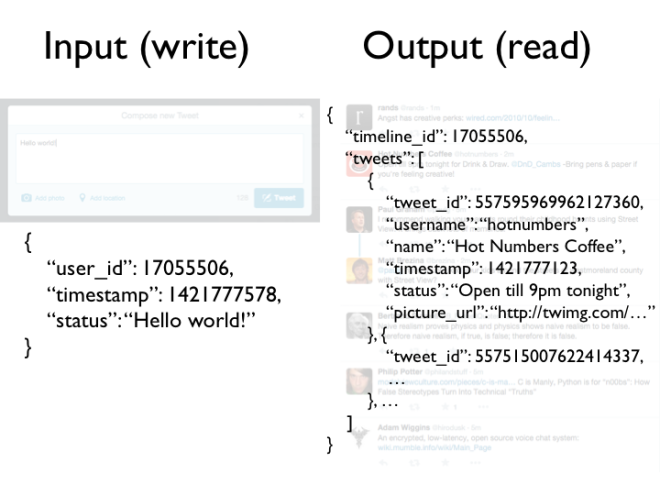 For each tweet, you now have not just the text, timestamp and user ID, but also the name of the user, their profile photo, and other information that has been joined with the tweet. Also, the list of tweets has been selected based on the people you follow, which may itself change.
For each tweet, you now have not just the text, timestamp and user ID, but also the name of the user, their profile photo, and other information that has been joined with the tweet. Also, the list of tweets has been selected based on the people you follow, which may itself change.
How would you go from the simple input to the more complex output? Well, you could try expressing it in SQL, something like this: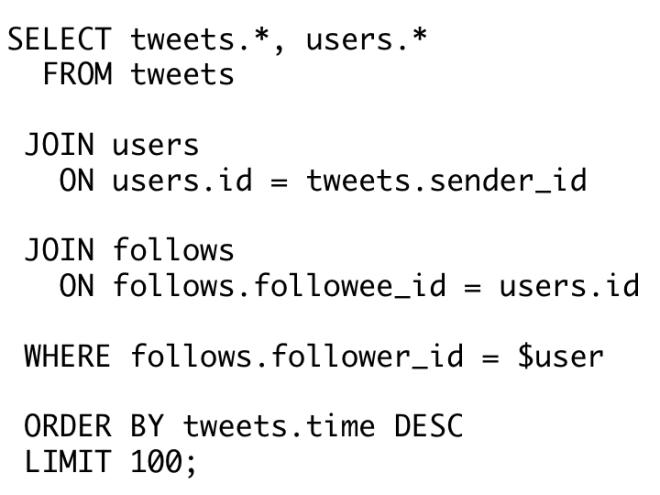 That is, find all of the users who $user is following, find all the tweets that they have written, order them by time and pick the 100 most recent. Turns out this query really doesn’t scale very well. Do you remember in the early days of Twitter, when they kept having the fail whale all the time? Apparently that was essentially because they were using something like the query above.
That is, find all of the users who $user is following, find all the tweets that they have written, order them by time and pick the 100 most recent. Turns out this query really doesn’t scale very well. Do you remember in the early days of Twitter, when they kept having the fail whale all the time? Apparently that was essentially because they were using something like the query above.
When a user views their timeline, it’s too expensive to iterate over all the people they are following to get those users’ tweets. Instead, Twitter must compute a user’s timeline ahead of time, and cache it, so that it’s fast when a user looks at it. To do that, they need a process that translates from the write-optimized event (a single tweet) to the read-optimized aggregate (a timeline). Twitter has such a process, and calls it the fanout service.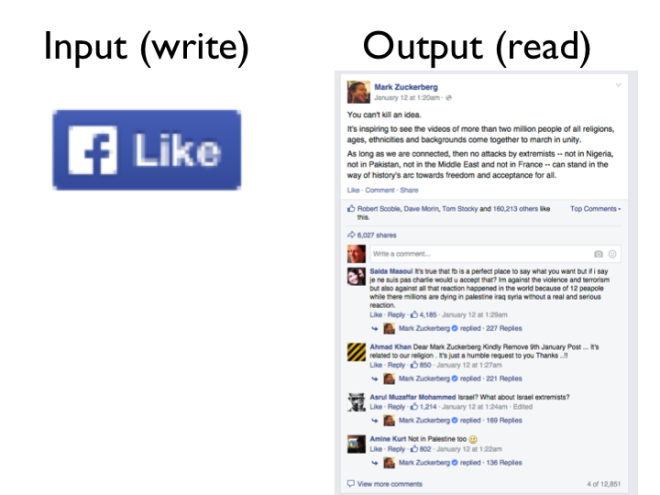
Another example: take Facebook. It has many buttons that enable you to write something to Facebook’s database, but a classic one is the “Like” button. When you click it, that generates an event, a fact with a very simple structure: you (identified by your user ID) like (an action verb) some item (identified by its ID).
However, if you look at the output side, reading something on Facebook, it’s incredibly complicated. In this example we have a Facebook post which is not just some text, but also the name of the author and his profile photo; and it’s telling me that 160,216 people like this update, of which three have been especially highlighted (presumably because Facebook thinks that amongst the likers of this update, these are the ones I am most likely to know); it’s telling me that there are 6,027 shares and 12,851 comments, of which the top 4 comments are shown (clearly some kind of comment ranking is happening here); and so on.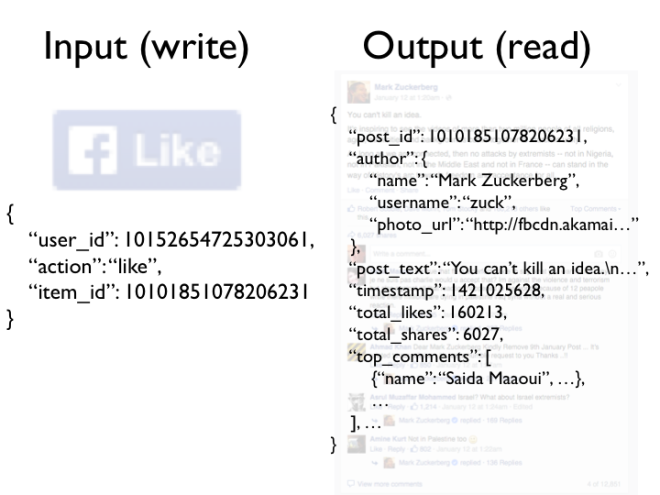
There must be some translation process happening here, which takes the very simple events as input, and produces the massively complex and personalized output structure. You can’t even conceive what the database query would look like to fetch all the information in that Facebook update. There is no way they could efficiently query all of that on the fly, not with over 100,000 likes. Clever caching is absolutely essential if you want to build something like this.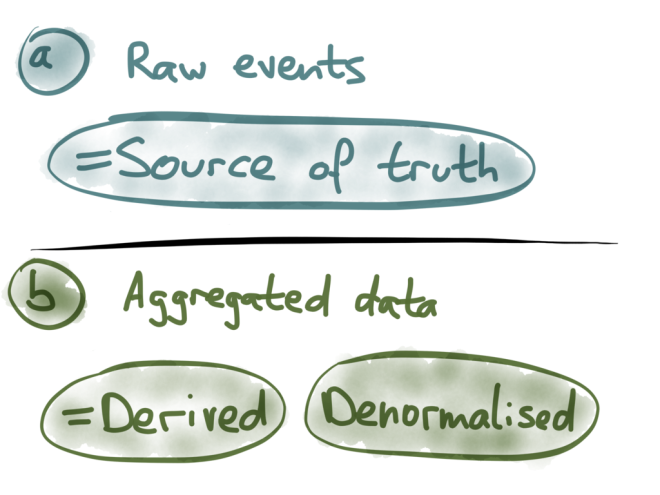
From the Twitter and Facebook examples we can see a certain pattern: the input events, corresponding to the buttons in the user interface, are quite simple. They are immutable facts, we can simply store them all, and we can treat them as the source of truth.
Everything that you can see on a website, i.e. everything that you read from the database, can be derived from those raw events. There is a process which derives those aggregates from the raw events, and which updates the caches when new events come in, and that process is entirely deterministic. You could, if necessary, re-run it from scratch: if you feed in the entire history of everything that ever happened on the site, you can reconstruct every cache entry to be exactly as it was before. The database you read from is just a cached view of the event log.
The beautiful thing about this separation between source of truth and caches is that in your caches, you can denormalize data to your heart’s content. In regular databases, it is often considered best practice to normalize data, because if something changes, you then only have to change it one place. Normalization makes writes fast and simple, but means you have to do more work (joins) at read time.
In order to speed up reads, you can denormalize data, i.e. duplicate information in various places so that it can be read faster. The problem is now that if the original data changes, all the places where you copied it to also need to change. In a typical database, that’s a nightmare, because you may not know all the places where something has been copied. But if your caches are built from your raw events using a repeatable process, you have much more freedom to denormalize, because you know what data is flowing where.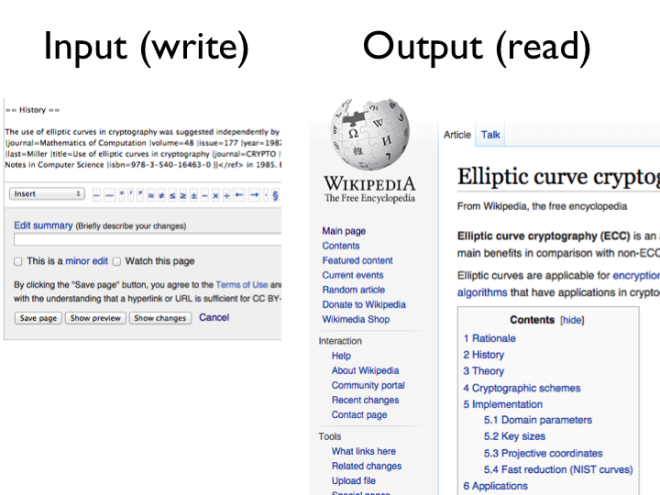
Another example: Wikipedia. This is almost a counter-example to Twitter and Facebook, because on Wikipedia the input and the output are almost the same.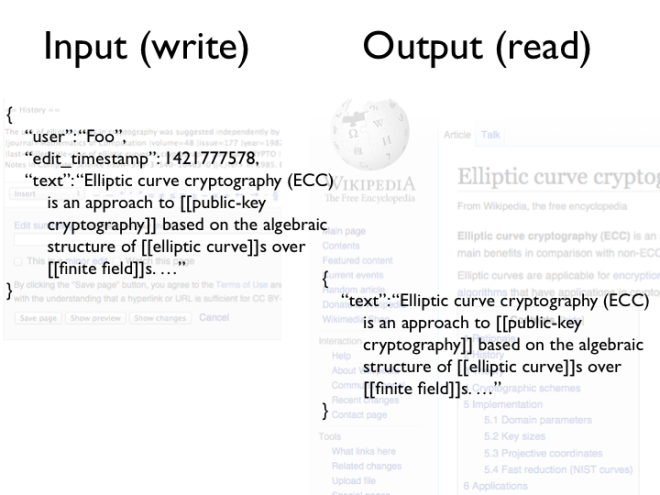
When you edit a page on Wikipedia, you get a big text field containing the entire page content (using wiki markup), and when you click the save button, it sends that entire page content back to the server. The server replaces the entire page with whatever you posted to it. When someone views the page, it returns that same content back to the user (formatted into HTML).
So, in this case, the input and the output are the same. What would event sourcing mean in this case? Would it perhaps make sense to represent a write event as a diff, like a patch file, rather than a copy of the entire page? It’s an interesting case to think about. (Google Docs works by continually applying diffs at a character granularity — effectively an event per keystroke.)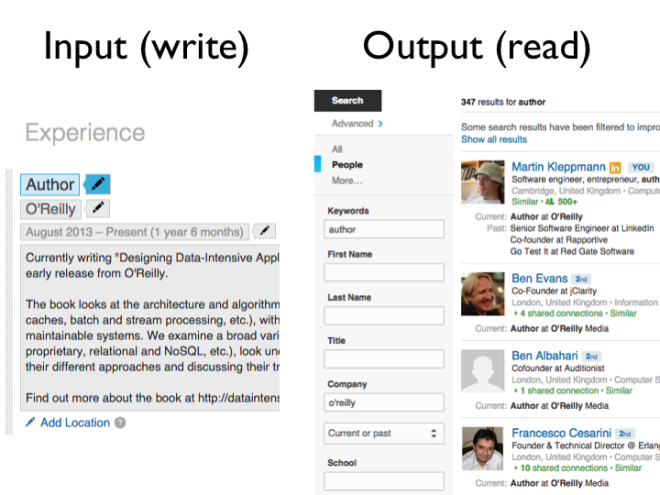
Final example: LinkedIn. Say you update your LinkedIn profile, and add your current job, which consists of a job title, a company, and some text. Again, the edit event for writing to the database is very simple.
There are various ways how you can read this data, and in this example, let’s look at the search feature. On the output side, one way you can read LinkedIn’s database is by typing some keywords and maybe a company name into a search box, and find all the people matching those criteria.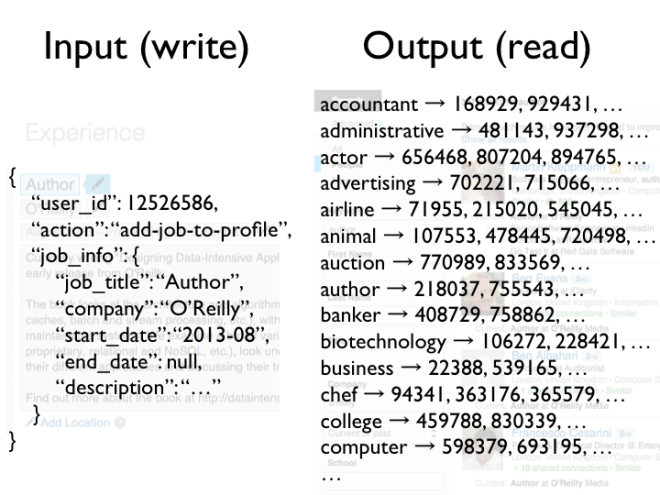
How is that implemented? Well, in order to search, you need a full-text index, which is essentially a big dictionary — for every keyword, it tells you the IDs of all the profiles that contain the keyword. This search index is another aggregate structure, and whenever some data is written to the database, this structure needs to be updated with the new data.
So for example, if I add my job “Author at O’Reilly” to my profile, the search index must now be updated to include my profile ID under the entries for “author” and “o’reilly”. The search index is just another kind of cache. It also needs to be built from the source of truth (all the profile edits that have ever occurred) and it needs to be updated whenever a new event occurs (someone edits their profile).
 Now, returning to stream processing. I first described how you might build something like Google Analytics, and compared storing raw page view events versus aggregated counters, and discussed how you can maintain those aggregates by consuming a stream of events.
Now, returning to stream processing. I first described how you might build something like Google Analytics, and compared storing raw page view events versus aggregated counters, and discussed how you can maintain those aggregates by consuming a stream of events.
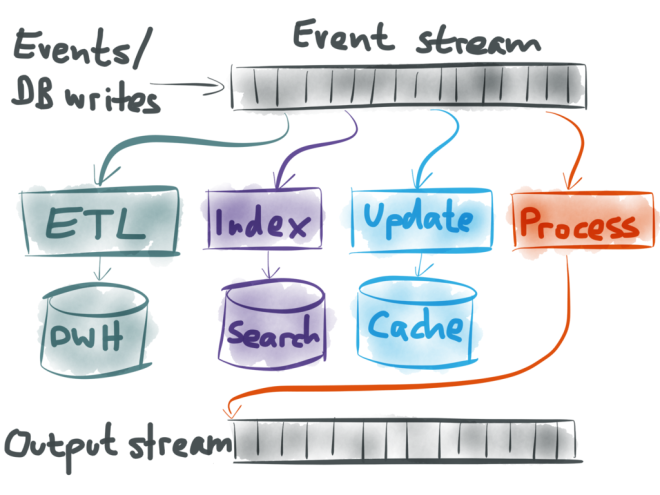 I then explained event sourcing, which applies a similar approach to databases: treat all the database writes as a stream of events, and build aggregates (views, caches, search indexes) from that stream. Once you have that event stream, you can do many great things with it:
I then explained event sourcing, which applies a similar approach to databases: treat all the database writes as a stream of events, and build aggregates (views, caches, search indexes) from that stream. Once you have that event stream, you can do many great things with it:
- You can take all the raw events, perhaps transform them a bit, and load them into a big data warehouse where analysts can query the data to their heart’s content.
- You can update full-text search indexes, so that when a user hits the search box, they are searching an up-to-date version of the data.
- You can invalidate or refill any caches, so that reads can be served from fast caches while also making sure that the data in the cache remains fresh.
- And finally, you can even take one event stream, and process it in some way (perhaps joining a few streams together) to create a new output stream. This way, you can plug the output of one system into the input of another system. This is a very powerful way of building complex applications cleanly.
 Moving to an event-sourcing-like approach for databases is a big change from the way that databases have traditionally been used (where you can update and delete data at will). Why would you want to go to all that effort of changing the way you do things? What’s the benefit of using append-only streams of immutable events?
Moving to an event-sourcing-like approach for databases is a big change from the way that databases have traditionally been used (where you can update and delete data at will). Why would you want to go to all that effort of changing the way you do things? What’s the benefit of using append-only streams of immutable events?
Several reasons:
- Loose coupling. If you write data to the database in the same schema as you use for reading, you have tight coupling between the part of the application doing the writing (the “button”) and the part doing the reading (the “screen”). We know that loose coupling is a good design principle for software. By separating the form in which you write and read data, and by explicitly translating from one to the other, you get much looser coupling between different parts of your application.
- Read and write performance. The decades-old debate over normalization (faster writes) vs. denormalization (faster reads) exists only because of the assumption that writes and reads use the same schema. If you separate the two, you can have fast writes and fast reads.
- Event streams are great for scalability, because they are a simple abstraction (comparatively easy to parallelize and scale across multiple machines), and because they allow you to decompose your application into producers and consumers of streams (which can operate independently, and can take advantage of more parallelism in hardware).
- Flexibility and agility. Raw events are so simple and obvious that a “schema migration” doesn’t really make sense (you may just add a new field from time to time, but you don’t usually need to rewrite historic data into a new format). On the other hand, the ways in which you want to present data to users are much more complex, and may be continually changing. If you have an explicit translation process between the source of truth and the caches that you read from, you can experiment with new user interfaces by just building new caches using new logic, running the new system in parallel with the old one, gradually moving people over from the old system, and then discarding the old system (or reverting to the old system if the new one didn’t work). Such flexibility is incredibly liberating.
- Finally, error scenarios are much easier to reason about if data is immutable. If something goes wrong in your system, you can always replay events in the same order, and reconstruct exactly what happened (especially important in finance, where auditability is crucial). If you deploy buggy code that writes bad data to a database, you can just re-run it after you fixed the bug, and thus correct the outputs. Those things are not possible if your database writes are destructive.

Finally, let’s talk about how you might put these ideas into practice.
I should point out that in reality, database writes often already do have a certain event-like immutable quality. The write-ahead log that exists in most databases is essentially an event stream of writes, although it’s very specific to a particular database. The MVCC mechanism in databases like PostgreSQL, MySQL’s InnoDB and Oracle, and the append-only B-trees of CouchDB, Datomic and LMDB are examples of the same thinking: it’s better to structure writes as an append-only log than to perform destructive overwrites.
However, here we’re not talking about the internals of storage engines, but about using event streams at the application level.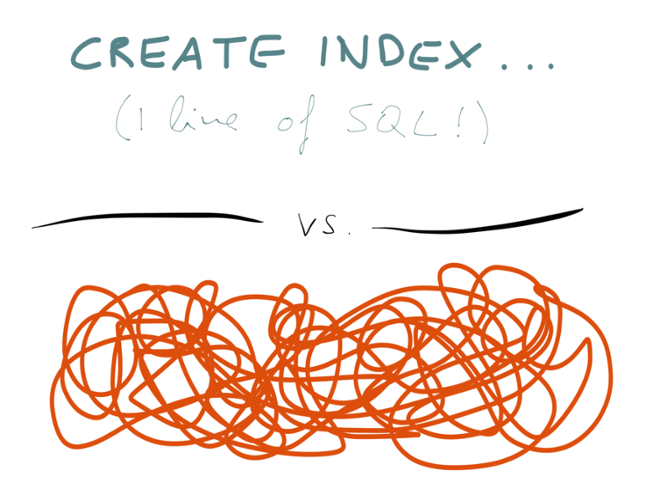 Some databases such as Event Store have oriented themselves specifically at the event sourcing model, and some people have implemented event sourcing on top of relational databases. Those may be viable solutions if you’re operating at fairly small scale.
Some databases such as Event Store have oriented themselves specifically at the event sourcing model, and some people have implemented event sourcing on top of relational databases. Those may be viable solutions if you’re operating at fairly small scale.
The systems I have worked with most are Apache Kafka and Apache Samza. They are open source projects that originated at LinkedIn, and now have a big community around them. Kafka is a message broker, like a publish-subscribe message queue, which supports event streams with many millions of messages per second, durably stored on disk and replicated across multiple machines.
Samza is the processing counterpart to Kafka: a framework which lets you write code to consume input streams and produce output streams, and it handles stuff like deploying your code to a cluster and recovering from failures.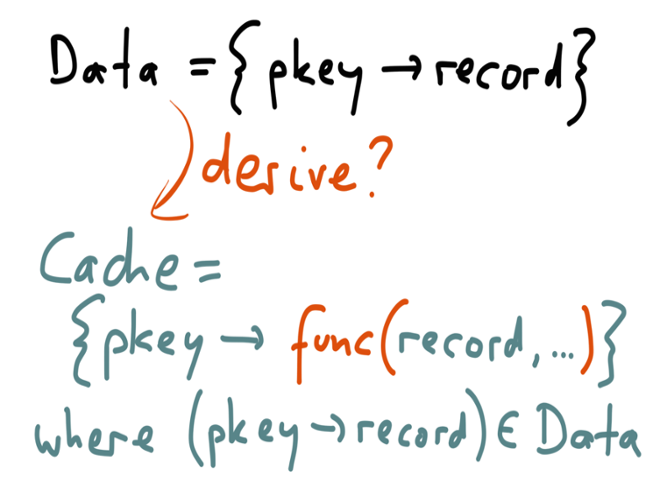 I would definitely recommend Kafka as a system for high-throughput reliable event streams. On the processing side, there are a few choices: Samza, Storm and Spark Streaming are the most popular stream processing frameworks. They all allow you to run your stream processing code distributed across multiple machines.
I would definitely recommend Kafka as a system for high-throughput reliable event streams. On the processing side, there are a few choices: Samza, Storm and Spark Streaming are the most popular stream processing frameworks. They all allow you to run your stream processing code distributed across multiple machines.
There are interesting design differences (pros and cons) between these three frameworks, which I don’t have time to go into here. You can read up a detailed comparison between them in the Samza documentation. And yes, I also think it’s funny that they all start with the letter S.
Today’s distributed stream processing systems have come out of internet companies (Samza from LinkedIn, Storm from Backtype/Twitter). Arguably, they have their roots in stream processing research from the early 2000s (TelegraphCQ, Borealis, etc), which originated from a relational database background. Just as NoSQL datastores stripped databases down to a minimal feature set, modern stream processing systems look quite stripped-down compared to the earlier research.
The modern stream processing frameworks (Samza, Storm, Spark Streaming) are mostly concerned with low-level matters: how to scale processing across multiple machines, how to deploy a job to a cluster, how to handle faults (crashes, machine failures, network outages), and how to achieve reliable performance in a multi-tenant environment. The APIs they provide are quite low-level (e.g. a callback that is invoked for every message). They look much more like MapReduce and less like a database. They are more interested in reliable operation than in fancy features.
By contrast, there is also some work on high-level query languages for stream processing, and Complex Event Processing is especially worth mentioning. It originated in 1990s research on event-driven simulation, and most CEP products are commercial, expensive enterprise software (only Esper is free/open source, and it’s limited to running on a single machine).
With CEP, you write queries or rules that match certain patterns in the events. They are comparable to SQL queries (which describe what results you want to return from a database), except that the CEP engine continually searches the stream for sets of events that match the query and notifies you (generates a “complex event”) whenever a match is found. This is useful for fraud detection or monitoring business processes, for example.
For use cases that can be easily described in terms of a CEP query language, such a high-level language is much more convenient than a low-level event processing API. On the other hand, a low-level API gives you more freedom, allowing you to do a wider range of things than a query language would let you do. Also, by focussing their efforts on scalability and fault tolerance, stream processing frameworks provide a solid foundation upon which query languages can be built.
A related idea is doing full-text search on streams, where you register a search query in advance, and then get notified whenever an event matches your query. We’ve done some experimental work with Luwak in this area, but it’s still very new. Finally, there are a lot of other things that are somehow related to stream processing. Going into laundry-list mode, here is a brief summary:
Finally, there are a lot of other things that are somehow related to stream processing. Going into laundry-list mode, here is a brief summary:
- Actor frameworks such as Akka, Orleans and Erlang OTP are also based on streams of immutable events. However, they are primarily a mechanism for concurrency, less a mechanism for data management. Some actor frameworks do have a distributed component, so you could build a distributed stream processing framework on top of actors. However, it’s worth looking carefully at the fault-tolerance guarantees and failure modes of these systems: many don’t provide durability, for example.
- There’s a lot of buzz around “reactive“, which seems to encompass a quite loosely-defined set of ideas. My impression is that there is some good work happening in dataflow languages and functional reactive programming (FRP), which I see as mostly about bringing event streams to the user interface, i.e. updating the user interface when some underlying data changes. This is a natural counterpart to event streams in the data backend.
- Finally, change data capture (CDC) means using an existing database in the familiar way, but extracting any inserts, updates and deletes into a stream of data change events which other applications can consume. This is a great migration path towards a stream-oriented architecture, and I’ll be talking and writing more about CDC in future.
I hope this talk helped you make some sense of the many facets of stream processing!
Martin Kleppmann is a software engineer and entrepreneur. He is a committer on Apache Samza and author of the upcoming O’Reilly book Designing Data-Intensive Applications. He’s @martinkl on Twitter.
Did you like this blog post? Share it now
Subscribe to the Confluent blog
Stop Treating Your LLM Like a Database
GenAI thrives on real-time contextual data: In a modern system, LLMs should be designed to engage, synthesize, and contribute, rather than to simply serve as queryable data stores.
Generative AI Meets Data Streaming (Part III) – Scaling AI in Real Time: Data Streaming and Event-Driven Architecture
In this final part of the blog series, we bring it all together by exploring data streaming platforms (DSPs), event-driven architecture (EDA), and real-time data processing to scale AI-powered solutions across your organization.

